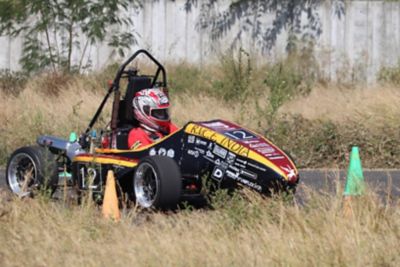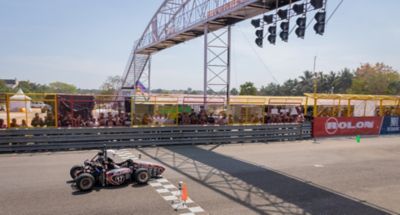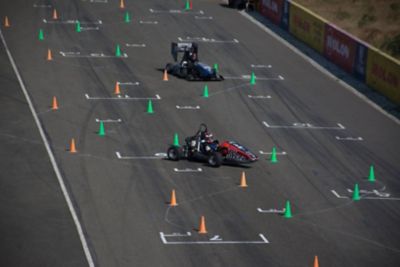-
United States -
United Kingdom -
India -
France -
Deutschland -
Italia -
日本 -
대한민국 -
中国 -
台灣
-
Ansys is committed to setting today's students up for success, by providing free simulation engineering software to students.
-
Ansys is committed to setting today's students up for success, by providing free simulation engineering software to students.
-
Ansys is committed to setting today's students up for success, by providing free simulation engineering software to students.
-
Contact Us -
Careers -
Students and Academic -
For United States and Canada
+1 844.462.6797
ANSYS BLOG
December 7, 2021
Ansys Supports Formula Bharat and Other Student Teams in Their Success on and off the Track
Formula events bring a significant element of mystery and excitement to racing, from initial vehicle development to the celebrity of the drivers and the skill of the racing teams as they participate in incredibly high-speed, high stakes competitions. They represent the convergence of the best engineering and technological vision in the automotive space. The investment in product development and optimization behind them often generates hi-tech solutions that have a significant impact on future vehicle development extending well beyond the track.

In Formula Bharat, the stakes couldn’t be higher for Indian student teams as they design, prototype, and build their vehicles. Formula Bharat and many student teams like them are critical to the future of motorsports and automotive manufacturing, where members of the teams represent some of the brightest new minds in engineering. To this end, Ansys works with Formula Bharat, as well as other student teams around the world in support of simulation in engineering education.
Competing in Formula Bharat
This year over 80 Formula Bharat teams were responsible for designing, prototyping, and manufacturing their vehicles before the competition. The actual event happens in two stages. The first involves the designing of the vehicle on a virtual platform using Ansys simulation tools. Once teams are selected to manufacture their vehicles, team members from various disciplines come together to bring their expertise to the project. Some work on the actual build, while others refer to the technical specifications of the design on a laptop. These student teams generally build most of their vehicles on campus, running multiple Ansys simulations to fine-tune them as they go.
Once the cars are built, the student teams descend at the Formula Bharat competition at the Kari Motor Speedway, to compete against each other, and the teams enter the second stage of the competition, which is broken into static and dynamic events. The static events involve engineering design, cost and manufacturing, and technical inspection, while the dynamic events consist of time spent on a skid pad course driving in concentric circles, an acceleration event driving in a straight line, and final endurance event.

Becoming a Knowledge Partner
To work with the competition even more, Ansys participated in Formula Bharat as a “Knowledge Partner” of an academic training series that is focused on connecting student participants with industry knowledge, as well as the simulation software they’ll need to successfully compete. Industrial leaders, including engineers from Ansys participate in the academic series and connect with the student team. Working together, these thought leaders give students the appropriate training, information about the latest technology, or an overview of the latest trends to help propel their careers.
“The value of this partnership lies within the Ansys academic ecosystem,” says Vishal Ganore, academic project manager responsible for managing academic partnerships at Ansys. “The student competition partnership program runs parallel to Ansys’ goal of early adoption of our simulation tools starting in university. Eventually these students will land somewhere in industry having already developed the Ansys skills needed for their engineering careers.”
Making Valuable Connections Outside of the Classroom
The value for students working on student teams like Formula Bharat is in the connections made between what they’ve learned in school, and how this knowledge is applied to real-world applications. In a traditional classroom, students learn the engineering fundamentals covering several principles through subjects such as computational fluid dynamics and finite element analysis. Learning is completely theory oriented. Once students start working on their vehicles, all the theories they’ve learned on paper come to life. They understand how the engineering works through their own experiences, and how to apply the fundamentals they’ve learned in the classroom. They have the opportunity to use industry-leading Ansys tools and solvers to build their cars, including Ansys Discovery, a next-generation product design software with a low barrier to entry, and flagship products such as Ansys Mechanical , Ansys Fluent, and Ansys Electronics.
“By their very nature, these competitive teams give students a real boost professionally once they graduate,” says Ganore, . “Students get the required skill set needed to apply their engineering knowledge using Ansys tools. And companies usually show a preference for students with knowledge of simulation going into the job.”
Team Building with Simulation
Ansys began supporting student teams in 2012, which often required Ganore to participate in the competitions, to judge the engineering design of a vehicle, for example. At that time there were 50 teams at most. Since then, the number of teams Ansys supports has grown to more than 500 from around the world. Like Formula Bharat, there are many other engineering competitions evolving around the world, and Ansys continues to work with these competitions and student teams to support their work, onboarding each student competition team with the Ansys software needed for them to succeed.

Of course, support does not stop with software. Ansys provides additional resources to teams including online learning through Ansys Innovation Courses with courses created specifically for student teams, free access to the Ansys Learning Hub and technical support through the Ansys Learning Forum to further facilitate team learning.
Ansys’ support of student teams is shaping the engineering thought leaders of tomorrow. Learn more about our contributions to student teams here.











